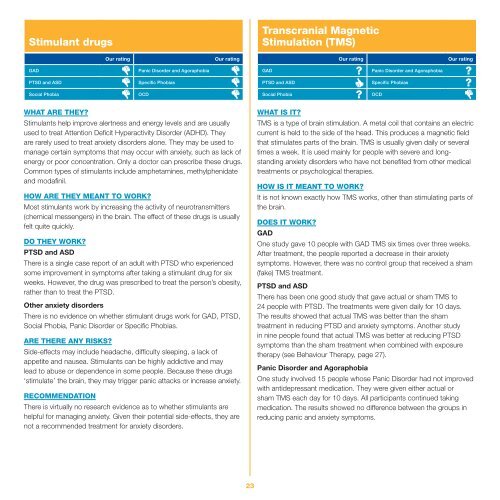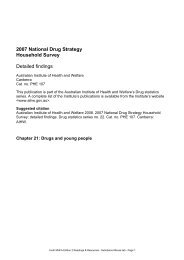A Guide To What Works For Anxiety Disorders - Mental Health First Aid
A Guide To What Works For Anxiety Disorders - Mental Health First Aid
A Guide To What Works For Anxiety Disorders - Mental Health First Aid
You also want an ePaper? Increase the reach of your titles
YUMPU automatically turns print PDFs into web optimized ePapers that Google loves.
Stimulant drugsTranscranial MagneticStimulation (TMS)GADPTSD and ASDOur ratingPanic Disorder and AgoraphobiaSpecific PhobiasOur ratingOur ratingOur ratingGAD? Panic Disorder and Agoraphobia ?PTSD and ASD Specific Phobias?Social PhobiaOCDSocial Phobia? OCDWHAT ARE THEY?Stimulants help improve alertness and energy levels and are usuallyused to treat Attention Deficit Hyperactivity Disorder (ADHD). Theyare rarely used to treat anxiety disorders alone. They may be used tomanage certain symptoms that may occur with anxiety, such as lack ofenergy or poor concentration. Only a doctor can prescribe these drugs.Common types of stimulants include amphetamines, methylphenidateand modafinil.HOW ARE THEY MEANT TO WORK?Most stimulants work by increasing the activity of neurotransmitters(chemical messengers) in the brain. The effect of these drugs is usuallyfelt quite quickly.DO THEY WORK?PTSD and ASDThere is a single case report of an adult with PTSD who experiencedsome improvement in symptoms after taking a stimulant drug for sixweeks. However, the drug was prescribed to treat the person’s obesity,rather than to treat the PTSD.Other anxiety disordersThere is no evidence on whether stimulant drugs work for GAD, PTSD,Social Phobia, Panic Disorder or Specific Phobias.ARE THERE ANY RISKS?Side-effects may include headache, difficulty sleeping, a lack ofappetite and nausea. Stimulants can be highly addictive and maylead to abuse or dependence in some people. Because these drugs‘stimulate’ the brain, they may trigger panic attacks or increase anxiety.RECOMMENDATIONThere is virtually no research evidence as to whether stimulants arehelpful for managing anxiety. Given their potential side-effects, they arenot a recommended treatment for anxiety disorders.WHAT IS IT?TMS is a type of brain stimulation. A metal coil that contains an electriccurrent is held to the side of the head. This produces a magnetic fieldthat stimulates parts of the brain. TMS is usually given daily or severaltimes a week. It is used mainly for people with severe and longstandinganxiety disorders who have not benefited from other medicaltreatments or psychological therapies.HOW IS IT MEANT TO WORK?It is not known exactly how TMS works, other than stimulating parts ofthe brain.DOES IT WORK?GADOne study gave 10 people with GAD TMS six times over three weeks.After treatment, the people reported a decrease in their anxietysymptoms. However, there was no control group that received a sham(fake) TMS treatment.PTSD and ASDThere has been one good study that gave actual or sham TMS to24 people with PTSD. The treatments were given daily for 10 days.The results showed that actual TMS was better than the shamtreatment in reducing PTSD and anxiety symptoms. Another studyin nine people found that actual TMS was better at reducing PTSDsymptoms than the sham treatment when combined with exposuretherapy (see Behaviour Therapy, page 27).Panic Disorder and AgoraphobiaOne study involved 15 people whose Panic Disorder had not improvedwith antidepressant medication. They were given either actual orsham TMS each day for 10 days. All participants continued takingmedication. The results showed no difference between the groups inreducing panic and anxiety symptoms.23




